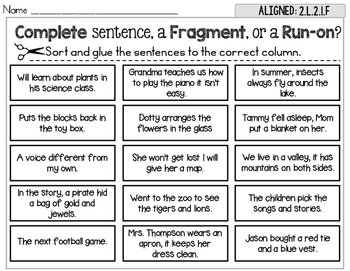

Then, scan your sentences for subordinating conjunctions. If you can recognize those things, you’re halfway there. How do you find and fix your fragments? Remember the basics: subject, verb, and complete thought. They took the bus because their car was in the shop.įinally, you need to know that every dependent clause needs to be attached to an independent clause (remember, the independent clause can stand on its own). Look at how these clauses switched places in the sentence:īecause their car was in the shop, they took the bus. The dependent clause and the independent clause can switch places, but the whole clause moves as one big chunk.

Third, you need to know that the subordinator (and the whole dependent clause) doesn’t have to be at the beginning of the sentence. Time: after, as, before, since, when, whenever, while, until.Possibility / Conditions: if, whether, unless.Place & Manner: how, however, where, wherever.Comparison / Contrast: although, even though, though, whereas, while.Cause / Effect: because, since, so that.Here is a list of common subordinating conjunctions and the relationships they indicate: Second, you need to recognize the subordinators when you see them. make one of the sentences dependent on the other for a complete thought (make one a dependent clause).If you know something about subordinating conjunctions, you can probably eliminate 90% of your fragments.įirst, you need to know that subordinating conjunctions do three things: These words belong to a special class of words called subordinators or subordinating conjunctions. So what makes the thought incomplete? It’s the first word (Because, After, When, Since, If). If you want to go with me (…What should you do?)ĭoes each of these examples have a subject? Yes. Since you asked (…Will you get the answer?) When you finally take the test (…What will happen?) They’re just begging for more information to make the thoughts complete:īecause their car was in the shop (…What did they do?)

They’re called “dependent” because they can’t stand on their own (just like some people you might know who are SO dependent!). The fragments that most students have trouble with, however, are dependent clauses-they have a subject and a verb, so they look like complete sentences, but they don’t express a complete thought. Some fragments are incomplete because they lack either a subject or a verb, or both. Sentence fragmentsĪ sentence fragment is an incomplete sentence. No matter how long or short the other sentence parts are, none of them can stand alone and make sense.īeing able to find the main subject, the main verb, and the complete thought is the first trick to learn for identifying fragments and run-ons. Wishing they’d brought their umbrella and dreaming of their nice warm bed, they waited for the bus all morning in the rain last Tuesday, determined to make it to class for their test.Īs your sentences grow more complicated, it gets harder to spot and stay focused on the basic elements of a complete sentence, but if you look carefully at the examples above, you’ll see that the main thought is still that they waited-one main subject and one main verb.

Wishing they’d brought their umbrella, they waited for the bus all morning in the rain last Tuesday. They waited for the bus all morning in the rain last Tuesday. But independent clauses (i.e., complete sentences) can be expanded to contain a lot more information, like this: We can understand the idea completely with just those two words, so again, it’s independent-an independent clause. This sentence has a subject (They) and a verb (waited), and it expresses a complete thought. Some sentences can be very short, with only two or three words expressing a complete thought, like this:
#Sentence fragment quiz pdf how to
The basicsīefore we get to the problems and how to fix them, let’s take a minute to review some information that is so basic you’ve probably forgotten it. It will help you locate and correct sentence fragments and run-ons. If instructors have ever returned your papers with “frag,” “S.F.,” “R.O.,” or “run-on” written in the margin, you may find this handout useful. Fragments and Run-ons What this handout is about


 0 kommentar(er)
0 kommentar(er)
